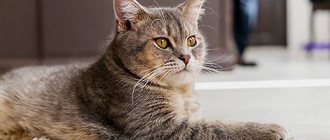To the question: “Does your cat go outside?” – many will answer “No”. And they can be understood. But some owners would still really like their kitty to be able to frolic outside, run through the grass, play with rustling, fallen leaves, or simply explore the world around her. After all, this is a lot of positive emotions for a cat. How can we be here then? How to walk a cat? After all, you don’t want to lose your cat by sending it outside, and you don’t like isolating your purring cat from the world?
A cat on the street exposes itself to many dangers. This includes infection with infectious diseases, ticks, fleas, and parasites, and a cat can bring all this into the house. Let's add here fights with other animals, the danger of getting hit by a car or getting lost, and refusal to walk becomes categorical.
Is it possible to walk a cat
This question cannot be answered directly. Inexperienced owners can only be advised to compare the life of a pet cat with their own. Both a person and a cat, theoretically, can spend their entire lives within the four walls of an apartment, feeling not bad at all. But you don’t want to sit in a stuffy room all the time, do you?
Only by walking and playing on the street can an animal feel true freedom and the charm of life, which will immediately sparkle with new colors. The pet will rejoice and will delight the owner with its desire to chase insects and lie on the grass, basking in the rays of the warm sun. Regular walks will strengthen the cat's respiratory and nervous system and make it more resilient.
Many people will wonder whether it is possible to walk a cat in winter. It is clear that in winter it is very cold outside, so you need to act carefully, gradually accustoming the animal to low temperatures. Again, everything will depend on the wishes and well-being of the pet itself. For some lovers of home warmth, a short stay on the balcony will be enough.
Alternative methods
If the above tips did not help and your cat constantly asks to go outside, try making the front door an unpleasant, perhaps even frightening place for your pet.
As soon as the cat approaches the front door, begins to meow heart-rendingly, asking for a walk, or sits, waiting for an opportunity to escape, try to scare the animal. Spray a stream of water from a spray bottle, clap your hands, shout at the cat or shake a metal can of coins, throw in the keys. Cats are afraid and do not like sharp rustling, whistling, rustling sounds. As soon as the cat leaves the door, caress, praise the mustachioed pet, and give him his favorite treat. Special sprays, aerosols with repellent aromas, citrus peels placed near the threshold, and containers with essential oils will help keep cats away from the front door.
But if you see that your pet is still sad and needs freedom, from time to time take him for a walk, but only on a special harness. Walk your cat in secluded, quiet places. You can place the cat in a special spacious enclosure or a cage for transportation, arranging its space properly.
The cat continues to ask to go outside, and, as a rule, this behavior worsens during the period of sexual heat (spring, autumn), in this case, special means that reduce sexual desire, which the veterinarian will prescribe, will help. But do not forget that long-term use of such drugs provokes hormonal imbalance and leads to the development of systemic failures in the body. Therefore, if the animal is not of breeding value, you do not plan to adopt a pet; castration and sterilization will help wean the cat off from walking.
In any case, whether or not to wean your cat from the street is entirely your decision. But do not forget that, despite all the attractiveness of freedom, it is on the street, especially in large cities, that a lot of dangers await pets, ranging from banal injuries, bruises to serious infections and diseases.
When not to walk your cat
Not all cats and not always can be taken outside even under the control of the owner.
Veterinarians recommend not walking:
- small kittens until they complete the vaccination schedule;
- cats over the age of five years old, not previously accustomed to the street;
- pregnant cats (they can easily catch “contagious” diseases);
- sick or “recovering” pets;
- “inadequate” cats during heat;
- unsterilized cats and cats without owner supervision.
Pros and cons of being outside
Solo street walks have many advantages and disadvantages. Such a pastime has the following advantages:
Tips for new residents on how to properly introduce their beloved cat into a new apartment
- Staying in the fresh air has a beneficial effect on the health of the animal. The cat has many opportunities for physical development: he will run a lot, jump, climb trees and walk along fences. All this is especially useful for pets prone to weight gain.
- An inquisitive representative of the cat tribe on the street receives many new impressions. This improves his mood and increases vitality.
- On the street, the cat follows its natural instincts: sharpens its claws, hunts, runs and tumbles. In a secluded place, he can make a nest for himself, where he will hide and observe the world around him.
- If a cat walks outside, the life of the owners will become more comfortable. A four-legged friend will be less likely to tear furniture and curtains with his claws, as well as mark surrounding objects.
At the same time, street walks are fraught with many dangers for your pet. The following threats exist:
- The most serious danger to cats is cars. Animals are threatened not only by busy city highways, but also by quiet country roads, where a cat may be frightened by a suddenly appearing car. Animals often hide under cars, and when the car moves sharply, the animal may not have time to jump out from under the wheels.
- An inquisitive pet may wander too far from its place of residence and get lost. Sometimes cats get into someone else's garage or utility room, where they can be accidentally locked.
- A walking pet is threatened by dogs, foxes, and aggressive brothers.
- As a result of interaction or fights with other animals, especially stray animals, a domestic cat can become infected with various diseases. These are viral infections, fungal diseases and much more.
- Pets often pick up fleas, ticks and other ectoparasites on the street. There is also a high risk of helminth infection.
- The animal may eat poisonous bait, a sick or poisoned rodent. It can be poisoned by antifreeze, garden pest control, or rat poison.
- A domestic cat whose natural instincts are weakened may also eat a dangerous poisonous plant, such as a lily or poinsettia.
Ancient ancestors of cats and what they looked like
How to walk a cat for the first time
When planning to walk cats on a leash, be prepared for an ambiguous reaction from your pets: the animal may be very frightened, or it may be so carried away by the walk that it wants to run away from you. Therefore, check the strength of the leash in advance, then attach it to the harness and hit the road, taking the puppy in your arms or placing it in a carrier.
Don’t put the cat down on the ground right away, let her look around, sniff and get used to it. If your pet is very frightened, it is better to accustom it to walking on the ground gradually, taking it outside for a few minutes every morning. Do not put off outdoor trips for too long: the animal will experience stress like the first time, forgetting about previous impressions.
Purpose of collars
Collars are purchased in particular for anti-parasitic purposes, as well as in case the animal gets lost or something happens to it. A medallion is attached indicating the cat's name, owner's phone number or address.
Using a cat harness
This is where a harness can help us. Of course, walking with a harness will somewhat limit the mustachioed’s fun, but it will also protect him from a lot of things. Therefore, you can discuss what steps to take to train your cat to go outside.
First, purchase a comfortable cat harness (a dog leash will not work) and begin to accustom your cat to it. At first, the harness can simply lie in a visible and accessible place for the cat, just let her get used to it. Then, wear only a harness, no leash, and try to distract the animal with something pleasant. For example, a treat or a game. If the cat tries to rip off the collar, do not follow her lead, continue to interest her in something and remove the collar when she calms down and is distracted. Then she will not associate the harness with something extremely unpleasant.
In the following days, repeat the procedure, not forgetting about the reward for your cat. Then, we begin to attach the leash itself. Having attached it, walk behind the cat and under no circumstances pull it by the leash.
You are just insurance, not the leader of its movement. If you try to command your cat where to go by pulling the leash, the cat will simply lie down on the floor and lie there.
Making a leash at home
You can do without buying it in a store by making your own cat leash at home using a long strip of thick fabric, scissors and a ring with a carabiner.
- A strip of fabric is folded in half lengthwise, stitched with thick thread, and the cut ends are folded over, securing them securely.
- Then a palm loop is made at one end, and a ring with a carabiner is firmly secured at the other.
Here is one way to make a leash for a cat without resorting to buying it in stores.
How to put on a harness
There are different types of harnesses, but cats prefer the “H” and “8” models.
Option “H” is a pair of rings fastened with a strap (sometimes with two straps to provide greater protection, the second strap is attached from below parallel to the first). The “latch” of the larger ring is located immediately behind the front paws, the smaller ring is secured around the neck. The strap, connecting the rings along the back, does not allow them to “spread”.
The main difference between the second model, which has the shape of an infinity or a figure eight, from the first is the method of fixing the rings - the rings are connected directly to each other without the help of a strap.
There is only one “lock” on this model, and many owners find it difficult to put the harness on their cat. And you need to act without wisdom:
- open the lock;
- hang the first ring on your pet’s neck;
- place a hanging strap around the chest behind the front paws;
- close the “latch”.
Both models have proven themselves well, but mustaches react more calmly to the harnesses of the “H” option. Most likely, this is due to the fact that the cross strap prevents the ring from squeezing the throat too much.
Proper feeding of your pet
Many cat owners prefer ready-made food. These products provide balanced, high-quality nutrition. But if it is not budget category food containing harmful substances that lead to liver and kidney diseases
It is important to choose products that are appropriate for the age of the animal. For owners who do not have the opportunity to regularly purchase ready-made “extra” class food, it is better to feed the kitten with natural products, ensuring an optimal supply of all necessary microelements
It is understandable to want from the heart to feed a hungry homeless animal. But you need to understand that street life does not contribute to the proper digestion process. Most likely, the system functions are impaired. At first, the cat needs to be fed dietary food. Volumes should be reduced, overeating during the period of getting used to homemade food is unacceptable.
Proper feeding will allow the body to adapt to a new diet without stress and will avoid stool disturbances and diarrhea, which can lead to dehydration.
Precautionary measures
When you decide to take your cat outside, be sure to make sure that it has all its vaccinations and that the animal is healthy. In addition to the harness, attach a collar with a tag with your address to her neck and never let your baby go outside without it. Then, putting on a harness and placing the cat in a carrier bag, take the cat outside. It is desirable that it be a quiet place, without transport, many people and animals. After opening the bag, give Murka the opportunity to get comfortable and get out on her own. There is no need to pull it out by force. Even if the first times are limited to just sitting in an open bag and sniffing new smells. After all, this is a walk for pleasure.
When the cat starts to get out of the bag, just follow it wherever it likes, again, don’t try to guide it unnecessarily. The first forays outside can be limited to 10-15 minutes, and then the time on the street can be increased to an hour. After walking your cat outside, you need to wash its paws and regularly carry out preventive measures against parasites: worms, fleas, etc.
Walking equipment
Cats living in rural conditions from early childhood get used to taking walks only in the summer and on a free basis, remembering the path to the house. Living in an urban environment, it is more difficult for a cat to get used to the street environment, so the animal’s chance of getting lost is quite high.
In order for the pet to be able to walk outside without health consequences, the breeders came up with a special complex of several parts that is tied around the pet’s chest and front legs - a harness. Unlike a collar, from which any dexterous cat can get out in a matter of seconds, a harness sits securely on the pet’s body due to several attachment points. And even the most resourceful animal will not be able to get out of these “shackles.”
The harness, like the collar, is attached to the leash using a movable carabiner. This allows the pet to roam freely on the street, and the owner not to be afraid that his pet will slip away into the nearest basement.
This is interesting
Many cats love to walk so much that their owners manage to take them with them even to the sea or to the mountains. The cat named Paul has already visited many places with his owners, and recently conquered Mount Grays Peak, 4350 m high.
The McMillen family captures all the adventures of the gallant and brave cat and posts the photographs on the Internet. The cat is not afraid of living creatures, swims with pleasure and can withstand long walks.
Infections
One of the arguments against walking cats in the article I mentioned above was the fact that outdoors a cat can encounter fungi, in particular Histoplasma capsulatum. It is a soil fungus that forms mycelium in the environment and transforms into a yeast form in the host. Infection occurs through inhalation of dust.
Sounds scary. But a smart owner, when told such horror stories, will definitely make inquiries and find out that this fungus can infect not only animals, but also people. Therefore, logically, everyone, not just cats, needs to stay at home to be afraid of it. But we are not sitting. So why should cats?
In addition, this kind of fungi is part of the world around us and affects only weakened mammals. You encounter these and other fungi literally everywhere, but have any of you or anyone you know gotten sick? Such cases are rare. And all because our immune system does not sleep: for a healthy body, such fungi, like most bacteria, are nonsense. Even the fungi that cause ringworm are mainly dangerous only for children and small kittens: adult animals and people easily crush these fungi with their immunity.
But the factor of dangerous infections is worth taking into account and you need to prepare for it. However, it is not fungi that need to be feared most of all, but primarily panleukopenia (distemper), calicivirus infection and rabies. These are, indeed, dangerous infections, and therefore domestic cats that do not have vaccinations do not need to walk outside. In addition, they should not have contact with other animals that do not live in your family.
Unvaccinated pets have every chance of getting sick, even while at home. The same plague virus can be brought home on shoes along with particles of dirt. In general, vaccinations are needed in any case.
Behavior correction using pharmacological drugs
If the cat is overly emotional and continues to rush outside, pharmaceutical and veterinary pharmacological drugs that have distracting and sedative properties will help:
- catnip powder;
- tincture of valerian officinalis;
- drops "Cat-Bayun";
- “Stop-stress” drops.
Mating season. During periods of increased sexual activity in male cats, “love medicines” are used that contain sex hormones that affect the physiological cycle. The most famous:
- "Anti-meow";
- "Stop-intimate";
- "Sex barrier";
- "Contrasex."
However, abuse of such drugs can cause irreparable harm to the health of the body, contributing to the development of cancer. In this regard, the only radical method that simultaneously ensures housetraining and the cessation of stormy “mating periods” is sterilization. An animal deprived of gonads becomes calmer, more docile and affectionate, and the once desired freedom gradually loses its relevance.











